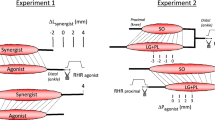Abstract
The relationship between nerve stimulation, pulse amplitude and isometric muscle force was measured to investigate recruitment of motor units. Force addition experiments were performed to obtain insight in the intersection of motor unit groups recruited by different electrodes. Intrafascicular and extraneural multielectrode configurations were used for nerve stimulation. Experiments were performed on rats. The common peroneal nerve was stimulated and the forces of the tibial anterior and extensor digitorum longus muscles were measured isometrically. Recruitment was more stable for intrafascicular electrodes than for extraneural electrodes. Especially for intrafascicular electrodes no strict inverse recruitment was observed. Force addition experiments indicated that small overlap of recruited motor unit groups occurred more often for intrafascicular than for extraneural electrodes.
Similar content being viewed by others
References
Bowman, B. R. andErickson, R. C. (1985) Acute and chronic implantation of coiled wire intraneural electrodes during cyclical electrical stimulation.Ann. Biomed. Eng.,13, 75–93.
Close, R. (1967) Properties of motor units in fast and slow skeletal muscles of the rat.J. Physiol.,193, 15–55.
Fang, Z.-P. andMortimer, J. T. (1987) A method for attaining natural recruitment order in artificially activated muscles. Proc. 9th Ann. Conf. IEEE Eng. in Med. & Biol. Soc., Boston, 13th–16th Nov. 1987, 657–658.
Freudenthal, H. (1965)Probability and statistics. Elsevier.
Gorman, P. H. andMortimer, J. T. (1983) The effect of stimulus parameters on the recruitment characteristics of direct nerve stimulation.IEEE Trans.,BME-30, 407–414.
Greene, E. C. (1968)Anatomy of the rat. Hafner.
Hays, W. L. (1973)Statistics for the social sciences, 2nd ed. Holt, Rinehart & Winston Inc.
Holle, J., Moritz, E., Thoma, H. andLischka, A. (1974) Die Karusselstimulation, eine neue Methode zur elektrophrenische Langzeitbeatmung.Weiner Klinische Wochenschrift,86, 23–27.
Ishihara, A., Naitoh, H. andKatsuta, S. (1987) Effects of ageing on the total number of muscle fibers and motoneurons of the tibialis anterior and soleus muscles in the rat.Brain Res.,435, 355–358.
McNeal, D. R. andBowman, B. R. (1985) Selective activation of muscles using peripheral nerve electrodes.Med. & Biol. Eng. & Comput.,23, 249–253.
Petrofsky, J. S. (1978) Control of recruitment and firing frequencies of motor units in electrically stimulated muscles in the cat.—Ibid.,,16, 302–308.
Petrofsky, J. S. (1979) Sequential motor unit stimulation through peripheral motor nerves in the cat.—Ibid.,17, 87–93.
Petrofsky, J. S. andPhillips, C. A. (1979) Determination of the contractile characteristics of the motor units in skeletal muscle through twitch characteristics.—Ibid.,17, 525–533.
Petrofsky, J. S. andPhillips, C. A. (1981) Impact of recruitment order on electrode design for neural prosthetics of skeletal muscle.Am. J. Phys. Med.,60, 243–253.
Solomonow, M., Eldred, E., Lyman, J. andFoster, J. (1983) Control of muscle contractile force through indirect highfrequency stimulation.—Ibid.,62, 71–82.
Sunderland, S. (1968)Nerves and nerve injuries. E. & S Livingstone.
Talonen, P., Baer, G., Huhti, M. andHäkkinen, V. (1985) Control of muscle force by sequential motor unit stimulation of peripheral nerves.Med. & Biol. Eng. & Comput.,23, Suppl., Part 1, 396–397.
Thoma, H., Holle, J., Moritz, E. andStöhr, H. (1978) Walking after paraplegia—a principle concept. 6th Int. Symp. on Ext. Control of Human Extr., Yugoslav Committee for Electronics & Automation, Dubrovnik, Sept. 1978, 71–80.
Veltink, P. H., van Alsté, J. A. andBoom, H. B. K. (1988a) Simulation of intrafascicular and extraneural nerve stimulation.IEEE Trans.,BME-35, 69–75.
Veltink, P. H., van Alsté, J. A. andBoom, H. B. K. (1988b) Influences of stimulation conditions on recruitment of myelinated nerve fibres: a model study.Ibid., IEEE Trans. BME-35, (in press).
Verveen, A. A. andDerksen, H. E. (1968) Fluctuation phenomena in nerve membrane.Proc. IEEE,6, 906–916.
Wallinga-de Jonge, W., Boom, H. B. K., Boon, K. L., Griep, P. A. M. andLammeree, G. C. (1980) Force development of fast and slow skeletal muscle at different muscle lengths.Am. J. Physiol.,239, C98-C104.
Wilkie, D. R. (1950) The relation between force and velocity in human muscle.J. Physiol.,110, 249–280.
Author information
Authors and Affiliations
Rights and permissions
About this article
Cite this article
Veltink, P.H., van Alsté, J.A. & Boom, H.B.K. Multielectrode intrafascicular and extraneural stimulation. Med. Biol. Eng. Comput. 27, 19–24 (1989). https://doi.org/10.1007/BF02442165
Received:
Accepted:
Issue Date:
DOI: https://doi.org/10.1007/BF02442165




